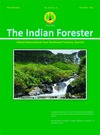Predatory Encounters between Orb-Weaver Spiders of Genus Neoscona Simon, 1864 (Araneae: Araneidae) and some Odonates: a Case Study from Nauradehi Wildlife Sanctuary, Madhya Pradesh, India
DOI:
https://doi.org/10.36808/if/2016/v142i11/105622Keywords:
Predatory Encounters, Prey, Orb-Weaver Spider, Neoscona, Odonates, Nauradehi Wildlife Sanctuary.Abstract
Prey and predator encounters are significant for studying predation behaviour of Orb-weaver spiders with reference to flying insects. Predatory encounters are studied between five species of Odonates (prey) and two species of Orb-weaver spiders (preadator) of Genus Neoscona belonging to family Araneidae based on four observations naturally occurred in the Nauradehi Wildlife Sanctuary, Madhya Pradesh, India during years 2012 and 2013 as different events. Factors involving behaviours of Orb-weaver spider and Odonate have influenced these predatory encounters.References
Champion H.G.and Seth S.K. (1968). A revised survey of forest types of India, Manager of Publications, Government of India, New Delhi: 404pp.
Coddington J.A. and Levi H.W. (1991). Systematicsand evolution of spiders. Ann. Rev. Ecol. Syst., 22:565-592.
Craig C.L. (1986). Orb web visibility: the influence of insect flight behavior and visual physiologyon the evolution of web designs within the Araneoidea, Anim. Behav.34: 54-68.
Craig C.L. (1988). Insect perception of spider orb webs in three light habitats,Functional Ecol., 2:277-282.
Eberhard W.G. (1986). Effects of orb-web geometry on prey interception and retention: in "Spiders: webs, behavior, and evolution" (ed. Shear, W. A.), Stanford Univ. Press, Stanford, 70-100.
Eisner T., Alsop R. and Ettershank G. (1964). Adhesiveness of spider silk, Science,164: 1058-1061.
Endo T. (1988). Patterns of prey utilization in a web of orb-weaving spider Araneus pinguis (Karsch), Res. Popul. Ecol., 30: 107-121.
Fraser F.C. (1933). The Fauna of British India, including Ceylon and Burma: Odonata, Vol. I, Taylor and Francis Ltd., London: 1-423.
Fraser F.C. (1936). The Fauna of British India including Ceylon and Burma: Odonata, Vol. III, Taylor and Francis Ltd., London: 1-461.
Kajak A. (1965). An analysis of food relations between the spiders (Araneus cornutus Clerck and Araneus quadrates Clerck) and their prey in meadows, Ekol.Pol., 13: 717-764.
Mitra T.R.(1994). Observations on the habits and habitats of adult dragonflies of Eastern India with special reference to the fauna of West Bengal, Records of Zoological Survey of India,166: 1-40.
Nentwig W. (1982). Why do only certain insects escape from a spider's web?. Oecologia,53: 412-417.
Riechert S.E. (1974). Thoughts on the ecologicalsignificance of spiders,Bioscience,24:352-356.
Riechert S.E. and Bishop L. (1990). Prey control byan assemblage of generalist predators: spiders ingarden test systems, Ecology,71 :1441-1450.
Robinson M.H. and Lubin Y.D. (1979a). Specialists and generalists: the ecology and behavior of some web building spiders from Papua New Guinea: I. Herennia ornatissima, Argiope ocyaloides and Arachnura melanura (Araneae: Araneidae), Pac. Insects,21(2-3): 97-132.
Robinson M.H. and Lubin Y.D. (1979b). Specialists and generalists: the ecology and behavior of some web building spiders from Papua New Guinea: II. Psechrus argentatus and Fecenia sp. (Araneae: Psechridae),Pac. Insects,21(2-3): 133-164.
Rodgers W.A., Panwar H.S. and Mathur V.B. (2002). Wildlife protected area network in India: A review, executive summary, Wildlife Institute of India, Dehradun,1-51.
Rypstra A.L.(1982). Building a better insect trap: an experimental investigation of prey capture in a variety of spider webs, Oecologia,52: 31-36.
Sherman Peter M. (1994). The orb-web: an energetic and behavioural estimator of a spider's dynamic foraging and reproductive strategies, Anim. Behav., 48: 19-34.
Tikader B.K. (1982). Family Araneidae (=Argiopidae) Typical Orbweavers: Fauna of India (Araneae), Zoological Survey of India, Kolkata, 2: 1-293.
Turnbull A.L. (1960). The prey of the spider Linyphia triangularis (Clerck) (Araneae: Linyphiidae), Can. J. Zool.,38: 859-873.
Uetz G.W. and Hartsock, S.P. (1987). Prey selection in an orb-weaving spider: Micrathena gracilis (Araneae: Araneidae), Psyche, 94: 103-116.
Vasconcellas-Neto J. and Lewinsohn T.M. (1984). Discrimination and release of unpalatable butterflies by Nephila clavipes, aneotropical orbweaving spider, Ecol. Entomol., 9: 337-344.
Downloads
Downloads
Published
How to Cite
Issue
Section
License
Unless otherwise stated, copyright or similar rights in all materials presented on the site, including graphical images, are owned by Indian Forester.





